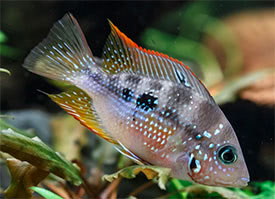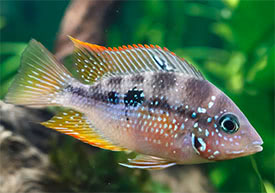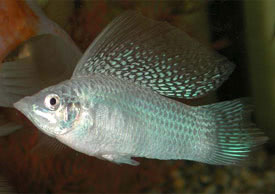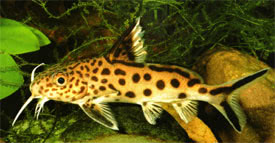
 Magyarul / Hungarian
Magyarul / Hungarian





- Scientific name: Thorichthys maculipinnis
- Synonyms: Thorichthys ellioti (Meek, 1904), Cichlasoma ellioti (Meek, 1904), Heros maculipinnis (Steindachner, 1864)
- Common name: Elliotis cichlid
- Group: Cichlids
- Habitat: Central America; South Mexico, in the Papaloapan River basin.
- Size: 15 cm
- Biotope: Inhabits slow-flowing, calm rivers, where they usually found in groups, over sandy or rocky substrates that often covered with dried leaf litter.
- Social behavior: Less aggressive than its relative the Firemouth cichlid (Thorichthys meeki). During spawning they may become a little territorial or aggressive, but their defended territory is not very large (usually 30-50 cm). Can be kept with other peaceful fish, or alone in a species tank.
- Diet: Omnivorous; They can be fed with a variety of live and frozen foods or with quality dried foods. They require some vegetable matter in their diet too.
- Breeding: Quite easy
- Tank: Minimum 150 litres.
- Population: 1 pair for 200 litres
- Decoration: Use sandy or small gravel substrate and build hiding places using bogwood or roots and larger stones. During spawning they may dig out the plants, so protect their roots with larger stones, or use some hard, well anchored plants like Anubias or Microsorum.
- Temperature: 25-28 °C
- pH: 7-8.5
- Hardness: 8-20 NK°
- Lifespan: 5-7 years
Description: In their natural habitat there are some color and morphological variants in different geographical areas. For example individuals inhabiting the Rio San Juan Evangelista have an intense yellow coloration on the ventral area together with the otherwise orange coloration of the fish. Fishes from the central part of the Papaloapan river system have an enhanced blue coloration on the scales along the sides as well as a longer snout. Fishes from the western parts of the Papaloapan River basin exhibit more and brighter bluish-green dots on the cheeks and lower part of the flanks. Both sexes have darker vertical bands, a reddish patch around the belly, and lots of shiny blue spots on the flanks and fins. There is a black patch about halfway along the flanks, and there is an eyespot on each gill cover. Males while defending their territories (especially during spawning) assume a threatening pose, facing each other with the gills open and making small runs forwards and backwards to scare away the intruders. The eyespts on the extended gill covers enable them to appear much larger than they really are. During these ritual fights they usually do not damage each other. Similarly to the South American eartheating cichlids they also like to sift the substrate with their mouths in search of food items, so a fine sandy substrate is recommended in their aquarium.
Thorichthys maculipinnis is not easy to sex, but mature males are a little larger than females, and most female fish have a dark blotch with a blue ring on the base of the dorsal fin during spawning. Males also change coloration during spawning: their flanks become light-blue and the posterior half of their body will be stunning purple. In nature breeding takes place mostly from February to May. Thorichthys maculipinnis is quite easy to breed in aquarium, once a pair has been established, so the best way to get a pair is to buy a small group of juveniles and let them form pairs. They become sexually mature at around 6-7cm in length. The male will choose a suitable territory that usually containing a flat rock and he will protect this territory against other males, while posing to the females and tries to lure them to the spawning site. The female will lay the eggs on a flat surface, while the male fertilizes them, and both parents will protect the eggs. The number of the eggs can vary between 100 and 300. The eggs hatch in 72 hours and the parents will move the larvae to a previously dug pit in the substrate. The larvae become free-swimming in 3-5 days and they start to search for food. The fry can be fed with newly hatched brine shrimp or powdered dry foods, and once they become larger, they can be fed with other live and frozen foods. The parents will usually care for their fry until they are between 1 and 2cm in length, but this may vary.























